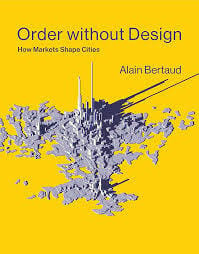- The Nebraska Planner
- Posts
- Order without Design
Order without Design
How Markets Shape Cities Summary

For the proud urban planner, Alain Bertaud’s Order without Design: How Markets Shape Cities, may quickly put them on the defensive. Indeed, many professional planners studied within design colleges, and approach the profession with the fundamental belief that quality places do not happen by accident. It’s understandable that Bertaud’s characterization of comprehensive planning as mostly a “very costly public relations operation” may compel an urban planner to quickly set the book to the side. But those who are able to suspend their own counterarguments long-enough to engage with the book’s substance may find helpful ideas and tools to integrate into their practice.
Bertaud’s central claim is that cities should be viewed as large labor markets. Planners’ two main objectives are, therefore, to increase mobility and affordability. For example, one central question for all planners to confront in Bertaud’s view could be, “How can we facilitate the most number of residents in the city to reach the most number of jobs in as little time as possible?”
In answering this question, followers of the Charles Marohn’s Strong Towns series of books will find in Bertaud’s writing a familiar call for humility by planners and city visionaries. Effective labor markets require thousands of nuanced decisions by individuals and businesses to make trade-offs such as price, location, and space. In Bertaud’s view, how can one person claim to know all these considerations, let alone manage them through regulations? While well-intentioned, Bertaud claims that such regulations, such as minimum floor space standards and detailed zoning by land use type, hurt residents, especially the poor, by restricting their participation in the full labor market.
The remaining chapters of the book work methodically through the topics of urban form, density, mobility, and affordability with this view of cities as labor markets in mind. Bertaud draws on theoretical scenarios, data-rich global case studies, and personal anecdotes to argue that planners should not try to “guide” development through a vision, but rather first seek to understand the market and plan smart investments to facilitate the market need for labor, income, amenities, and space.
In density, Bertaud would let land prices and the decisions of trade-offs in land, floor space, money, and commuting costs determine density of an area. Planners concerned about sprawl should, in his view, identify and minimize possible distortions in the land market.
In mobility, Bertaud advocates for planners to minimize the time and “friction” of workers to reach possible jobs, “accounting for the modes of transport that each income group can afford.” He dives into astonishing detail to account for the land consumed by each mode of transport, the cost of that land, and the passengers conveyed per hour to determine the efficiency of these transport modes in connecting people to jobs with as little friction as possible.
In affordability, Bertaud suggests planners can plan infrastructure to increase the supply of land to bring down housing costs, decrease commuting time and costs, and reduce rigidities of minimum lot and dwelling size.
It would be a mistake to characterize Bertaud’s argument as a call for non-planning. Rather, he argues the need to shift the scope of what is planned. He offers a vision of the profession in which planners would primarily monitor spatial distribution of jobs and housing, mobility, and affordability, watch for “blinking indicators” of bottlenecks and problems, audit their regulations, and draw primarily on the concept of supply and demand to find solutions.
Those who want to criticize Bertaud’s arguments will find plenty of opportunity. Bertaud himself seems unable to escape the subjective criteria he’s critical of as he acknowledges the need to mitigate the negative impacts of incompatible land uses and the validity of preserving the “charm” of neighborhoods and towns that itself can be an economic driver. As he criticizes the “utopian” ideas of planners, the idea of a city taking his advice and making purely rational economic decisions in a 100% free market democracy is clearly its own kind of fantasy.
The bones to be picked in Bertaud’s arguments, however, do not diminish the value of what he offers to planners in Order without Design: an extensive scaffolding to become a bit smarter and more responsive in their decision-making through a better understanding of markets.
Reply